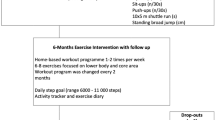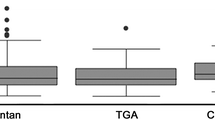Summary
After undergoing the Fontan procedure for congenital heart disease, 16 young patients performed a maximal treadmill test according to the Bruce protocol. The peak velocity of the blood flow in the ascending aorta, stroke index, and cardiac index were measured by continuous-wave Doppler echocardiography at rest and at each stage of the test. The results were compared with those from 18 normal children. The body surface area was similar in the two groups. The endurance time was 37% shorter in the Fontan group than in the control group. From the beginning of exercise until the sixth minute, the increase in stroke index was lower in the Fontan group (NS). After that point, the stroke index was maintained at a high level in the control group but decreased toward its original level in the Fontan group. The response of cardiac index to exercise in the two groups was comparable until the sixth minute, after which the Fontan group failed to maintain an ascending curve. All the hemodynamic values were significantly higher in the control group at maximal exercise; at this point the cardiac index had increased 79% in the Fontan group and 170% in the control group. The subnormal response of the stroke volume at submaximal exercise and the subsequent decrease at maximal exercise following the Fontan procedure are important hemodynamic findings.
Similar content being viewed by others
References
Alboliras ET, Julsrud PR, Danielson GK, et al (1987) Definitive operation for pulmonary atresia with intact ventricular septum.J Thorac Cardiovasc Surg 93:454–464
Bar-Or O, Shephard RJ, Allen CL (1971) Cardiac output of 10- to 13-year-old boys and girls during submaximal exercise.J Appl Physiol 30:219–223
Bruce RA, Kusumi F, Hosmer D (1973) Maximal oxygen intake and nomographic assessment of functional aerobic impairment in cardiovascular disease.Am Heart J 85:546–562
Cumming GR (1978) Maximal exercise capacity of children with heart defects.Am J Cardiol 42:613–619
Cumming GR, Everatt D, Hastman L (1978) Bruce treadmill test in children: normal values in a clinic population.Am J Cardiol 41:69–75
Daley PJ, Sagar KB, Wann LS (1985) Doppler echocardiographic measurement of flow velocity in the ascending aorta during supine and upright exercise.Br Heart J 54:562–567
Driscoll DJ, Danielson GK, Puga FJ, et al (1986) Exercise tolerance and cardiorespiratory response to exercise after the Fontan operation for tricuspid atresia or functional single ventricle.J Am Coll Cardiol 7:1087–1094
Driscoll DJ, Feldt RH, Mottram CD, et al (1987) Cardiore-spiratory response to exercise after definitive repair of univentricular atrioventricular connection.Int J Cardiol 17:73–81
Fontan F, Baudet E (1971) Surgical repair of tricuspid atresia.Thorax 26:240–248
Gewillig MH, Lundstrom UR, Bull C, Wyse RK, Deanfield JE (1990) Exercise responses in patients with congenital heart disease after Fontan repair: patterns and determinants of performance.J Am Coll Cardiol 15:1424–1432
Godfrey S, Davies CT, Wozniak E, Barnes CA (1971) Cardio-respiratory response to exercise in normal children.Clin Sci 40:419–431
Hagler DJ, Seward JB, Tajik AJ, Ritter DG (1984) Functional assessment of the Fontan operation: combined M-mode, two-dimensional and Doppler echocardiographic studies.J Am Coll Cardiol 4:756–764
Humes RA, Feldt RH, Porter J, et al (1988) The modified Fontan operation for asplenia and polysplenia syndromes.J Thorac Cardiovasc Surg 96:212–218
Iwase M, Maeda M, Noda S, et al (1990) Continuous wave Doppler echocardiographic evaluation of cardiac output in its application to treadmill exercise.Am J Noninvas Cardiol 4:159–166
James FW, Kaplan S, Glueck CHJ, et al (1980) Response of normal children and young adults to controlled bicycle exercise.Circulation 61:902–912
Lock JE, Einzig S, Moller JH (1978) Hemodynamic responses to exercise in normal children.Am J Cardiol 41: 1278–1284
Rhodes J, Garofano RP, Bowman FO, et al (1990) Effect of right ventricular anatomy on the cardiopulmonary response to exercise: implications for the Fontan procedure.Circulation 81:1811–1817
Shachar GB, Fuhrman BP, Wang Y, Lucas RV, Lock JE (1982) Rest and exercise hemodynamics after the Fontan procedure.Circulation 65: 1043–1048
Author information
Authors and Affiliations
Rights and permissions
About this article
Cite this article
Cortes, R.G.S., Satomi, G., Yoshigi, M. et al. Maximal hemodynamic response after the Fontan procedure: Doppler evaluation during the treadmill test. Pediatr Cardiol 15, 170–177 (1994). https://doi.org/10.1007/BF00800671
Issue Date:
DOI: https://doi.org/10.1007/BF00800671




